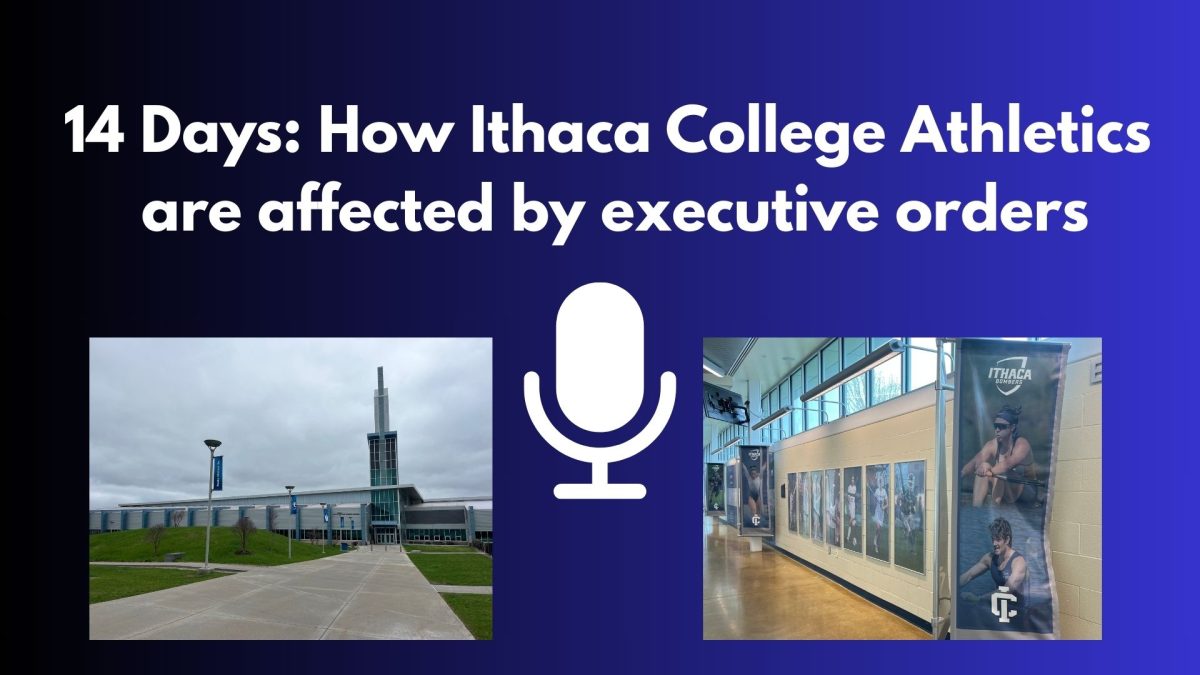Doing his best to dodge icy patches, Boris Dzikovski’s runs with snowshoe-clad feet through the Hammond Hill State Forest trails. Dzikovski is one of the leaders of the Finger Lakes Runners Club weekly snowshoe runs, and he says that this year, runners faced many physical dangers in the brutal cold.
[topswf swf=’https://www.ithacaweek-ic.com/wp-content/uploads/2015/04/RunningTrails.swf’ width=’550′ height=’400′ quality=’best’ wmode=’transparent’ scale=’default’ flashvars=” allowfullscreen=’false’]
“In winter, you have some cross country skiing, but if you go running it is totally unfriendly conditions,” he said. “You can slip, you can fall. You can break your hips, which has happened to me a number of times.”
According to the Northeast Regional Climate Center, this February was the coldest in Ithaca’s history. Intense wind chills, black ice and mountains of snow, are among the many physical dangers athletes face when choosing to run outdoors in extreme low temperatures. Winter running injuries are common, Jason Barton, from the Spinal Wellness Center of Ithaca, said, discussing conditions he has seen in patients.
“[A patient] strained the bottom of their foot running slushy, wet, icy conditions in the winter, that’s what I saw this year,” he said.
Even for experienced runners, this Winter’s conditions were extreme, Cole Crosby, a manager at the Finger Lakes Running & Triathlon Co. on the Commons, said.
“It’s definitely been tough when you have tons of snow plus cold wind chill, even for someone that runs 7 days a week all year long outside,” he said.
Dzikovski moved from Russia to teach at Cornell University 30 years ago, and said the cold winters were nothing new to him, but was interested in staying active outdoors, despite having to bundle up.
The most important thing to remember with any outdoor activities in the winter is to dress appropriately in order to avoid dangers like frostbite, Lisa Holt, manager of Finger Lakes Running, said.
“Extremely cold temperatures can impact breathing, often you’ll see runners with their mouths covered to warm the air up before their lungs,” she said.
Though there are dangers with outdoor running in the winter, there are ways to prevent them, Anton Krupicka, an American ultra-runner based in Boulder, CO, said.
“Paying attention to where the wind is coming from – running into the wind will always be colder than running with it – and dressing in layers is important,” he said.
Running outside is better for you, even though it may not seem as enjoyable at first glance, Dzikovski said.
“It probably is not as fun at first glance as summer running and less comfortable, but it is still more fun than hitting the treadmill or doing the same stuff or running on the track inside.”
Running on treadmills or tracks indoors can be harder on your muscles, Crosby said.
“Even though you’re running on a flat road, the road is always slightly undulating,” he said. “It makes you a little bit stronger, you build better posture from it, because there are all sorts of stabilizer muscles that work to help keep you nice and secure as you’re running. That’s something you lose with too much treadmill running.”
Though with the icy outdoor conditions, Barton said it’s safer to run indoors.
“If you don’t have your health, if you’re going to get injured, then you’re going to be really depressed,” he said. “You’re going to have a really tough winter if you’re injured.”
There are many options in Ithaca for group runs and events in the winter. The Finger Lakes Runners Club offers a Winter Chill 5K series, and Dzikovski organized a snowshoe race this past year they hope to get more participants in next year, hopefully with less brutal cold temperatures.













